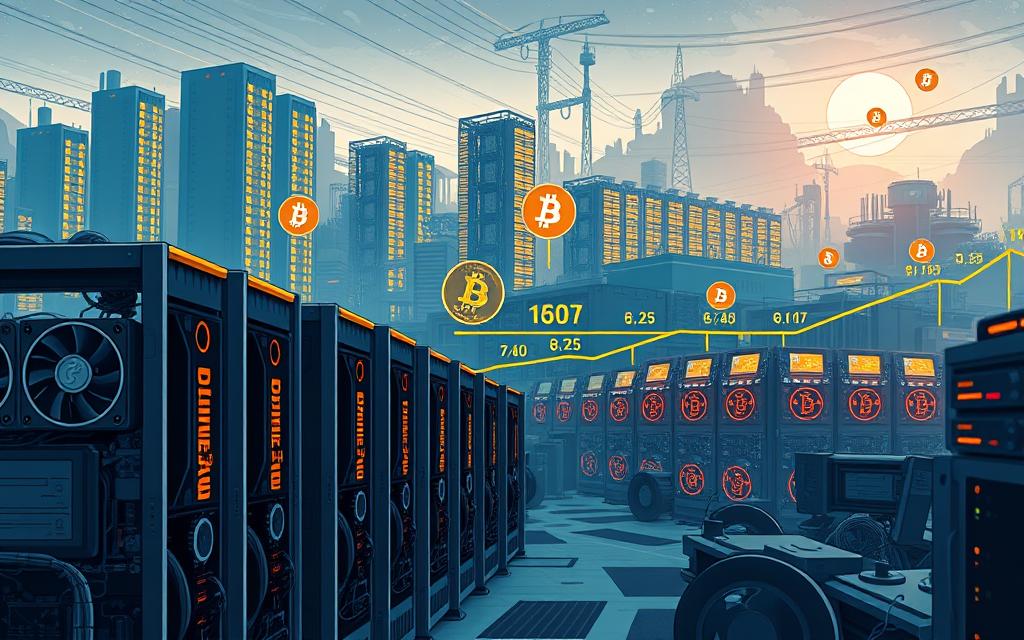Table of Contents
Bitcoin, launched in 2009, was designed as a decentralized alternative to traditional financial systems. Its design features a capped supply of 21 million coins, a characteristic that differentiates it from fiat currencies. The mining process, which involves solving complex mathematical puzzles, not only adds new Bitcoins to circulation but also secures the blockchain network.
The total supply of Bitcoins is capped at 21 million, and according to projections, all coins will be mined by the year 2140. As we approach this milestone, the reward for miners will transition from block subsidies to transaction fees. For a deeper dive into what happens after all Bitcoin is mined, you can explore the details on River.com.
This guide will explore the implications of Bitcoin’s scarcity model and its effects on the cryptocurrency ecosystem. Understanding the mining process and its time-based rewards is crucial for grasping the long-term trajectory of Bitcoin.
Understanding Bitcoin’s Limited Supply
One of the fundamental aspects of Bitcoin’s design is its limited supply, which is capped at 21 million. This characteristic distinguishes Bitcoin from traditional fiat currencies, which can be printed in unlimited quantities by central banks.
The 21 Million Bitcoin Cap
The total supply of Bitcoin is capped at 21 million units, a feature that is hardcoded into the Bitcoin protocol. This means that once 21 million Bitcoins have been mined, there will be no more new Bitcoins created, making it a deflationary currency. The limited supply is a key factor that contributes to Bitcoin’s value and price in the market.
| Currency | Supply Mechanism | Inflationary/Deflationary |
|---|---|---|
| Bitcoin | Capped at 21 million | Deflationary |
| Fiat Currencies | Unlimited printing | Inflationary |
| Gold | Limited by mining | Deflationary |
Why Bitcoin Has a Supply Limit
The creator of Bitcoin, Satoshi Nakamoto, implemented the supply limit as a response to the unlimited money printing by central banks during the financial crisis. The economic theory behind a deflationary currency is that it preserves purchasing power over time. By capping the supply of Bitcoin, Nakamoto aimed to create a currency that would appreciate in value over time, making it an attractive store of wealth.
How Bitcoin Mining Works
The Bitcoin mining process is fundamental to the operation of the Bitcoin network, facilitating both transaction validation and the creation of new Bitcoins. It involves a network of powerful computers competing to solve complex mathematical problems, which helps to secure the network and verify transactions.
The Role of Miners in the Bitcoin Network
Miners play a crucial role in the Bitcoin ecosystem by validating transactions and creating new blocks to be added to the blockchain. They use powerful hardware to solve complex mathematical equations, which requires significant computational power. This process not only helps to secure the network but also verifies the transactions, making them irreversible.
Block Rewards and Transaction Fees
Miners are incentivized to participate in the network through block rewards and transaction fees. Block rewards are the newly minted Bitcoins awarded to miners for solving the mathematical problems and creating a new block. Transaction fees, on the other hand, are paid by users to prioritize their transactions. As the block reward decreases over time due to halving events, transaction fees are expected to become a more significant source of revenue for miners.
Mining Difficulty and Hash Rate
The hash rate of the Bitcoin network is a measure of its overall computational power. The difficulty of mining is adjusted every 2016 blocks, or approximately every two weeks, to maintain a consistent block creation rate of about one block every 10 minutes. This adjustment mechanism ensures that the network remains secure and that the creation of new Bitcoins follows a predictable schedule, regardless of the total hash rate of the network.

| Aspect | Description | Impact |
|---|---|---|
| Mining Difficulty | Adjusted every 2016 blocks | Maintains a 10-minute block time |
| Hash Rate | Measure of network computational power | Influences mining difficulty |
| Block Rewards | New Bitcoins awarded to miners | Incentivizes miners to secure the network |
The Bitcoin Halving Process Explained
The Bitcoin halving process is a critical component of the cryptocurrency’s design, aimed at controlling the supply of new Bitcoins. This mechanism is fundamental to Bitcoin’s monetary policy and has a significant impact on its ecosystem.
What Is a Bitcoin Halving?
A Bitcoin halving is an event where the reward for mining new blocks is cut in half. This occurs approximately every four years, or after every 210,000 blocks are mined. The halving process is designed to slow down the issuance of new Bitcoins, thereby reducing inflation and increasing the cryptocurrency’s scarcity. For more information on the halving process, you can visit this resource.
Historical Bitcoin Halvings
Bitcoin has undergone several halving events since its inception. The first halving occurred in 2012, reducing the block reward from 50 BTC to 25 BTC. Subsequent halvings took place in 2016 and 2020, further reducing the block reward to 12.5 BTC and 6.25 BTC, respectively. The most recent halving in 2024 brought the block reward down to 3.125 BTC. Each halving event has significant implications for Bitcoin’s supply and demand dynamics.
Impact of Halvings on Bitcoin’s Inflation Rate
The halving events have a direct impact on Bitcoin’s inflation rate. As the block reward decreases, the rate at which new Bitcoins are issued slows down. For instance, during the 2016 halving, Bitcoin’s inflation rate dropped from approximately 3.7% to 1.8%, making it less inflationary than the U.S. Dollar’s inflation target of 2%. The 2024 halving further reduced Bitcoin’s inflation rate, making it even less inflationary than gold, a traditional store-of-value asset known for its low stock-to-flow ratio.
| Halving Year | Block Reward (BTC) | Inflation Rate (%) |
|---|---|---|
| 2012 | 25 | ~1.9% |
| 2016 | 12.5 | ~1.8% |
| 2020 | 6.25 | ~1.7% |
| 2024 | 3.125 | <2% |
When Will the Last Bitcoin Be Mined?
As the bitcoin network continues to evolve, the question of when the last bitcoin will be mined remains pertinent. The timeline for this event is closely tied to the bitcoin protocol’s design, particularly the halving mechanism and the total supply cap.
The 2140 Projection
The last bitcoin is currently projected to be mined around the year 2140. This projection is based on the bitcoin protocol’s algorithm, which is designed to gradually reduce the block reward over time through halving events. With a total supply cap of 21 million bitcoins, the gradual reduction in block rewards ensures that the mining process continues until the last bitcoin is mined.

Factors That Could Affect This Timeline
Several factors could potentially alter the projected timeline for the last bitcoin to be mined. Variations in average block time, currently targeted at 10 minutes, could accelerate or delay the mining schedule. The increasing hash power contributed by miners has historically led to blocks being found slightly faster than the 10-minute target, at around 9.5 minutes, thereby potentially bringing the last bitcoin mining date forward.
Other factors include potential protocol changes, which would require overwhelming consensus among stakeholders, and the impact of lost bitcoins, estimated at 3-4 million, on the effective supply. While lost bitcoins don’t change the mining timeline, they do affect the circulating supply, potentially influencing bitcoin price dynamics.
Understanding these factors is crucial for miners and investors alike, as they navigate the complexities of the bitcoin network and its time-based mechanisms.
Current State of Bitcoin Mining
Understanding the current state of Bitcoin mining is crucial for grasping the overall health of the Bitcoin network. The process of mining is not only vital for the creation of new bitcoins but also for the security and validation of transactions on the network.

Number of Bitcoins Mined So Far
As of now, a significant portion of the total 21 million bitcoins has been mined. The exact number can be obtained from reliable cryptocurrency data sources. The mining of bitcoins is done in blocks, with each block containing a specific number of bitcoins.
Daily Bitcoin Mining Rate
Currently, approximately 900 new bitcoins are mined daily. This figure is calculated based on the current block reward of 6.25 bitcoins per block and the average number of blocks mined per day, which is 144. The actual daily issuance can vary slightly due to changes in block time and mining difficulty adjustments.
The daily issuance of 900 bitcoins represents an annual inflation rate of less than 2%. This rate is expected to decrease after the next halving event in 2024, when the block reward will be reduced to 3.125 bitcoins per block, resulting in approximately 450 new bitcoins being mined daily.
The Economics of Bitcoin Mining
Understanding the economics of Bitcoin mining requires examining the interplay between mining revenue, energy consumption, and operational costs. The profitability of mining operations is influenced by several factors, including the cost of energy, the efficiency of mining equipment, and the current price of Bitcoin.
Mining Profitability Over Time
The profitability of Bitcoin mining has evolved significantly over time. Initially, mining was profitable with basic computer hardware, but as the network grew and mining difficulty increased, specialized hardware known as ASICs became necessary. These advancements have allowed miners to remain profitable, even after events like the halving, which reduces the block reward.
Energy Consumption and Efficiency
Bitcoin mining is often criticized for its energy consumption. However, miners are driven to use the cheapest energy sources available, often utilizing renewable energy or stranded energy that would otherwise be wasted. The efficiency of mining equipment has also improved dramatically, with each new generation of ASICs providing more hash power per watt of energy consumed.
| Year | Energy Consumption per TH/s | Average Cost of Energy |
|---|---|---|
| 2018 | 0.1 Joules/TH | $0.05/kWh |
| 2020 | 0.05 Joules/TH | $0.04/kWh |
| 2022 | 0.02 Joules/TH | $0.03/kWh |

The table illustrates the improvement in energy efficiency of Bitcoin mining hardware over the years, alongside the average cost of energy. As mining hardware becomes more efficient, the overall energy consumption per unit of hash power decreases, making mining more sustainable.
What Happens After All Bitcoins Are Mined
As the Bitcoin network approaches the end of its mining schedule, concerns arise about the future of its security and transaction validation. The miners play a crucial role in maintaining the integrity of the network, and their incentives will shift once the block reward is eliminated.
Transition to a Fee-Based Model
After all Bitcoins are mined, miners will rely solely on transaction fees to sustain their operations. Some people worry that transaction fees might not be enough to keep the network secure. While this concern is understandable, the continued growth of Bitcoin’s adoption shows that a strong fee market is possible. The Lightning Network, a layer-two solution, is expected to play a significant role in shaping the fee market and enhancing the security of the network.

Potential Changes to the Bitcoin Protocol
The Bitcoin community may consider changes to the protocol as the network approaches the end of its issuance schedule. Proposals have been suggested to address potential security concerns in a post-block-reward era. However, any changes would require overwhelming consensus from the Bitcoin community, making radical alterations improbable. The conservative approach to Bitcoin development suggests that major changes to the monetary policy are highly unlikely. Miners could potentially benefit from a more efficient fee market, but this will depend on the evolution of the network and its ecosystem.
Implications for Bitcoin’s Value and Adoption
Bitcoin’s finite supply is set to redefine its value proposition and influence its adoption rates. As the last Bitcoin is mined, the dynamics of scarcity will play a crucial role in shaping the cryptocurrency’s market.
Scarcity and Price Dynamics
The capped supply of 21 million Bitcoins creates a unique scarcity that could drive up demand and, consequently, the price. This scarcity is often compared to that of gold, a traditional store of value. As users become more aware of this limited supply, it may lead to increased adoption and a higher market price.

Bitcoin as a Deflationary Currency
Some economists worry that Bitcoin’s deflationary nature could hinder its ability to support an economy due to the perceived lack of sufficient units. However, Bitcoin’s divisibility into 100 million satoshis addresses this concern. Even as Bitcoin’s value rises, smaller amounts will retain purchasing power, making it viable for commerce. This divisibility ensures that the value of each satoshi, rather than the total number of Bitcoins, becomes the focal point.
The implications of a deflationary currency like Bitcoin are multifaceted. It may encourage saving and long-term investment, potentially altering consumer and business behavior. Historical examples of deflationary periods suggest that such a currency could lead to a more prudent financial approach among users.
Network Security After the Last Bitcoin
As the Bitcoin network approaches the milestone of mining its last coin, concerns about the future security of the network come to the forefront. The network relies heavily on the collective efforts of miners to validate transactions and secure the blockchain.

Will Transaction Fees Be Enough?
With the block reward dwindling, transaction fees will become the primary incentive for miners to continue validating transactions. The question remains whether these fees will be sufficient to maintain the network’s security.
- The more mining happening on the network, the more secure it is.
- A decline in total hash rate leads to a decline in mining difficulty.
Long-term Security Considerations
Several factors will influence the long-term security of the Bitcoin network. These include:
- The evolution of the security model as block rewards diminish.
- Potential attack vectors and their mitigations.
- The relationship between the value secured by the network and the resources required to attack it.
- The impact of technological advances in computing on the network’s security model.
Conclusion: The Future of Bitcoin Beyond Mining
As we look to the future, the impending end of Bitcoin mining marks a significant milestone in the cryptocurrency’s lifecycle. The projected timeline for the last bitcoin to be mined around 2140 represents a fundamental shift in the network’s dynamics. At this point, miners will transition from relying on block rewards to transaction fees as their primary source of revenue.
This transition underscores the need for Bitcoin to build sustainable value beyond the issuance phase. The fixed supply cap of 21 million bitcoins embodies the core philosophy of sound money and resistance to manipulation. As we consider Bitcoin’s potential role in the global financial system over the coming decades and centuries, it’s clear that the end of mining is not an endpoint but a transition to Bitcoin’s mature phase as a fully-issued currency.
Over time, as the network continues to evolve, the success of Bitcoin will depend on its ability to adapt and maintain its value proposition. In the years to come, Bitcoin is poised to play a significant role in shaping the future of finance.
FAQ
What is the total supply of Bitcoin?
The total supply of Bitcoin is capped at 21 million BTC, making it a scarce digital asset.
How does the Bitcoin halving process work?
The Bitcoin halving occurs approximately every four years, reducing the block reward for miners by half, thus decreasing the rate at which new Bitcoins are added to the circulation.
What happens to miners after all Bitcoins are mined?
After the 2140 projection for the last Bitcoin being mined, miners will rely on transaction fees as their primary source of revenue, ensuring the continued security of the Bitcoin network.
How many Bitcoins are mined daily?
The number of Bitcoins mined daily depends on the current block reward and the block time, which is approximately 10 minutes; currently, around 900 new Bitcoins are mined daily.
What is the role of miners in the Bitcoin network?
Miners validate transactions, secure the network through complex mathematical calculations, and are rewarded with newly minted Bitcoins and transaction fees for their efforts.
How does the halving affect Bitcoin’s inflation rate?
The halving reduces the rate at which new Bitcoins are issued, directly impacting Bitcoin’s inflation rate, making it more scarce and potentially affecting its price dynamics.
Will transaction fees be enough to secure the Bitcoin network after all Bitcoins are mined?
The transition to a fee-based model is expected to ensure the network’s security, as transaction fees will become the primary incentive for miners to continue validating transactions and securing the network.
How does the limited supply of Bitcoin impact its value?
The scarcity of Bitcoin, due to its capped supply, can influence its value, potentially driving up demand and, consequently, its price in the market.
What is the current state of Bitcoin mining?
As of now, a significant portion of the total 21 million Bitcoin supply has been mined, with the remaining Bitcoins to be mined until 2140.









